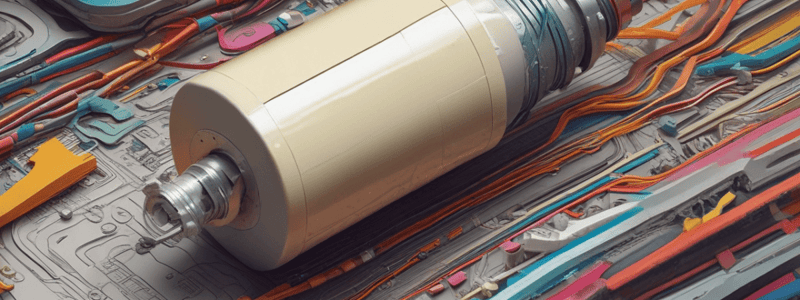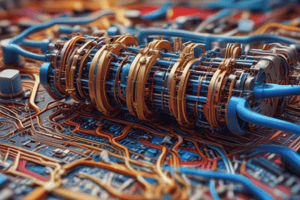Podcast
Questions and Answers
What parameter is defined as the ratio of a paper's inner area to its projected area?
What parameter is defined as the ratio of a paper's inner area to its projected area?
- Surface roughness
- Protein binding capacity
- Pore size (correct)
- Porosity
Which material is NOT listed as a potential hydrophobic agent for creating micron-scale capillary channels on paper?
Which material is NOT listed as a potential hydrophobic agent for creating micron-scale capillary channels on paper?
- Polyethylene (correct)
- Wax
- Paraffin
- Polystyrene
What is the preferred color for the paper in the context of colorimetric tests mentioned in the text?
What is the preferred color for the paper in the context of colorimetric tests mentioned in the text?
- Green
- Blue
- Yellow
- White (correct)
Which parameter relates to the time required for a sample to move along and saturate the paper with a defined length?
Which parameter relates to the time required for a sample to move along and saturate the paper with a defined length?
What type of charge is preferred in papers used for colorimetric tests according to the text?
What type of charge is preferred in papers used for colorimetric tests according to the text?
Which characteristic is NOT mentioned as a paper parameter for microfluidic paper-based devices in the text?
Which characteristic is NOT mentioned as a paper parameter for microfluidic paper-based devices in the text?
What is the purpose of using wax as the 'ink' in the wax printing fabrication method?
What is the purpose of using wax as the 'ink' in the wax printing fabrication method?
What is the key difference between the wax printing and the alkyl ketene dimer (AKD) printing methods for fabricating paper-based microfluidic devices?
What is the key difference between the wax printing and the alkyl ketene dimer (AKD) printing methods for fabricating paper-based microfluidic devices?
What is the primary function of the hydrophobic areas created by the AKD printing method in paper-based microfluidic devices?
What is the primary function of the hydrophobic areas created by the AKD printing method in paper-based microfluidic devices?
Which of the following properties of paper is the most important for its use in microfluidic devices?
Which of the following properties of paper is the most important for its use in microfluidic devices?
How does the AKD printing method modify the surface properties of the cellulose fibers in the paper?
How does the AKD printing method modify the surface properties of the cellulose fibers in the paper?
Which of the following is a key advantage of the wax printing fabrication method for paper-based microfluidic devices?
Which of the following is a key advantage of the wax printing fabrication method for paper-based microfluidic devices?
What are the key factors that enable the spontaneous filling of capillaries and microchannels?
What are the key factors that enable the spontaneous filling of capillaries and microchannels?
Which of the following is NOT a component of the capillary effect crucial for microfluidics?
Which of the following is NOT a component of the capillary effect crucial for microfluidics?
In paper-based microfluidics, what materials are commonly used to manufacture Paper-based Analytical Devices (µPADs)?
In paper-based microfluidics, what materials are commonly used to manufacture Paper-based Analytical Devices (µPADs)?
What is the minimum required content of α-cellulose in cellulosic materials used for manufacturing paper in microfluidics?
What is the minimum required content of α-cellulose in cellulosic materials used for manufacturing paper in microfluidics?
Which property of cellulosic paper makes it suitable for microfluidic applications?
Which property of cellulosic paper makes it suitable for microfluidic applications?
What role do Lateral Flow Strips (LFSs) play in the context of microfluidics?
What role do Lateral Flow Strips (LFSs) play in the context of microfluidics?
Flashcards are hidden until you start studying




